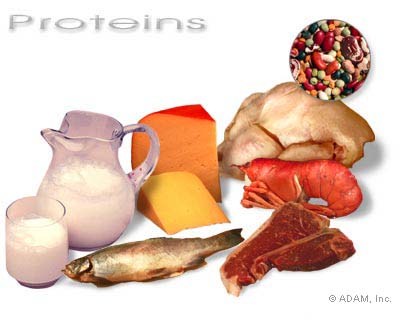
Protein
The picture above shows some examples of foods which contain proteins.
Proteins make up the structure of the body and are used for growth and repair of the following; muscles, skin, bones, internal organs, cartilage and ligaments. That is why 10-20% (depending on the needs of the individual) of your daily calorie intake should consist of protein. It is suggested that for every kg of body weight you should have 0.8g of protein. For every 1g of protein you have you get 4kcals of energy.
Amino acids are the smallest form of a protein. There are two types of amino acids; essential amino acids which you receive through your diet and non- essential amino acids which your body makes itself. The body is only able to make these non-essential amino acids itself if you have all the essential amino acids present in the body.
Essential Amino Acids
1. Isoleucine
2. Leucine
3. Lysine
4. Methionine
5. Phenylalanine
6. Threonine
7. Tryptophan
8. Valine
Non-essential Amino Acids
1. Cystein
2. Histidine
3. Glutamic acid
4. Alanine
5. Proline
6. Asparagine
7. Tryosine
8. Glutamine
9. Glycine
10. Serine
11. Aspartic acid
12. Arginine
You can get complete, incomplete and complementary proteins.
Complete Protein- this is a food which includes all of the 8 essential amino acids.
Incomplete Protein-this is a food which doesn’t consist of one or more essential amino acids.
Complementary Protein- this is when you mix your incomplete proteins so that your body still gets all 8 essential amino acids which it needs.
Biological value
This is a rating out of a hundred; it shows the amount of essential amino acids in a food. The higher the biological value, the higher the quantity of essential amino acids in the food. For example the biological value of an egg is 100; it has the highest amount of essential amino acids in it.
The Functions of protein
We digest proteins and they are taken to the liver as single amino acids. The amino acids are then rebuilt into long chains by the liver to make new proteins. The protein which is made is dependent on what the body needs most at the time.